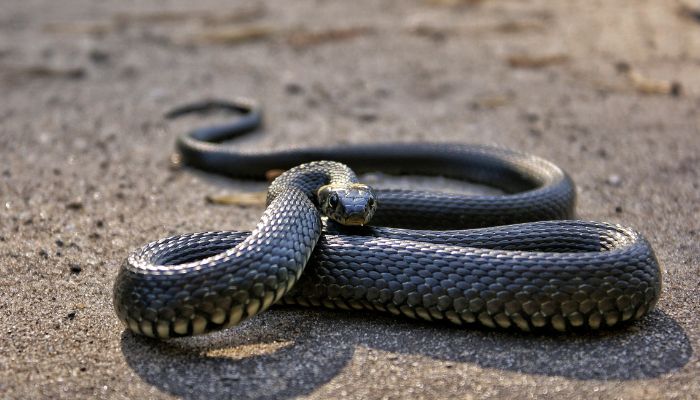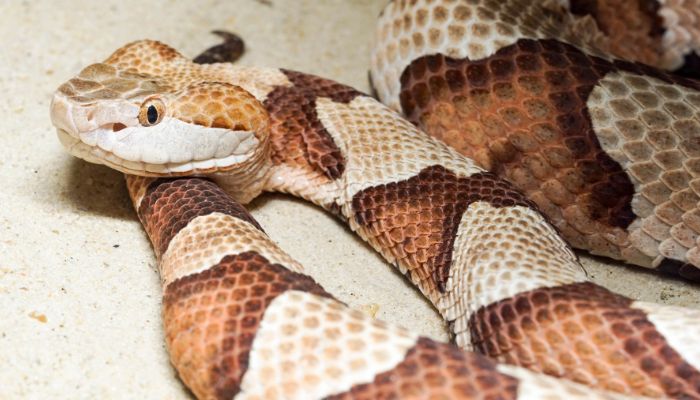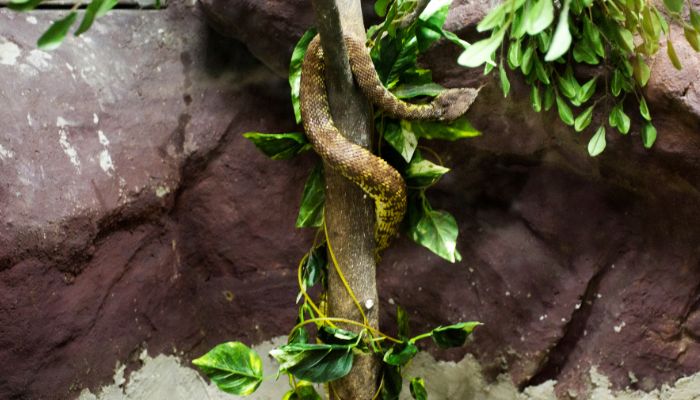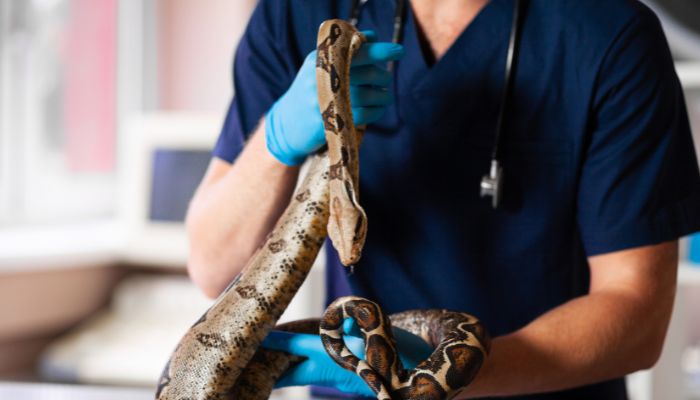
If you’ve ever found yourself pondering, “Why are my snake’s scales lifting?”, you’re not alone.
Many snake owners have faced this concern, often leading to a flurry of questions about their reptile’s health.
This article delves deep into the world of snake care, shedding light on the potential causes behind lifted scales, from environmental factors to health conditions like scale rot.
We’ve meticulously researched and consulted experts to provide you with comprehensive insights.
By the end of this read, you’ll not only understand the reasons behind this phenomenon but also be equipped with knowledge on prevention and treatment.
Dive in to ensure your slithery friend’s optimal health.
Table of Contents
Why are my snake’s scales lifting? (Caused by Scale Rot)
Your snake’s scales may be lifting due to a condition called scale rot, which is a bacterial infection that affects the reptile’s skin. This condition often arises from environmental factors such as incorrect temperatures, high humidity levels, or an unclean enclosure. Additionally, injuries or trauma, like those from rough substrates or live prey, can also lead to lifted scales. It’s essential to monitor your snake’s environment, maintain proper hygiene, and consult a reptile veterinarian if you notice such symptoms to ensure the well-being of your slithery companion.
The Concern Regarding a Snake’s Lifted Scales

Imagine this: You’re a proud snake owner, having spent countless hours researching the best care practices for your slithery friend. You’ve named it, perhaps something exotic like “Azura” or something playful like “Slinky.”
Every day, you marvel at its graceful movements and the mesmerizing patterns on its scales. But one day, as you’re admiring Slinky, you notice something amiss. The scales, once smooth and uniform, now appear lifted in some areas.
Panic sets in. Is Slinky sick? Have you done something wrong?
This scenario is all too familiar for many snake owners. The sight of lifted scales can be alarming, especially if you’re unsure of the cause.
It’s like noticing an unusual rash on your own skin and wondering if it’s just a minor irritation or a sign of something more serious.
Scale Rot as a Potential Cause

Enter the world of reptile health, where “scale rot” is a term that sends shivers down the spine of many snake enthusiasts. Just as humans can suffer from skin conditions, snakes too can experience issues with their scales.
Scale rot, in particular, is a bacterial infection that can make a snake’s scales lift, discolor, or even blister.
Let’s take a journey through a real-life example. Meet Jake, a snake enthusiast who recently faced this very issue. Jake had always been meticulous about the care of his pet python, Medusa.
But after a particularly humid week, he noticed Medusa’s scales looking discolored and lifted. Concerned, he delved into the world of snake forums and articles, coming across the term “scale rot.”
Jake learned that scale rot often arises due to environmental factors. Incorrect temperatures, high humidity levels, or an unclean enclosure can all contribute.
Remembering the recent humidity spike, Jake realized that Medusa’s enclosure might have become a breeding ground for bacteria.
But here’s the silver lining. Armed with knowledge and a determination to help Medusa, Jake took action. He adjusted the temperature and humidity levels, cleaned the enclosure thoroughly, and consulted a reptile vet.
With the right care, Medusa’s scales began to heal, and she was back to her lively self in no time.
The story of Jake and Medusa serves as a reminder that while issues like scale rot can be concerning, they’re also treatable. Knowledge, timely intervention, and a dash of love can make all the difference.
In the vast realm of snake ownership, understanding potential health concerns is crucial. Whether it’s scale rot or another issue, being informed and proactive can ensure that our slithery companions live healthy, happy lives.
So, the next time you notice something unusual about your snake’s scales, remember Jake and Medusa’s story. With the right care, every problem has a solution.
Recognizing Scale Rot: Symptoms

Imagine you’re a detective, and every case you solve revolves around the mysterious world of reptiles. One day, a concerned snake owner walks into your office, presenting a case that’s all too familiar: their beloved snake has some unusual symptoms.
As the detective, you know that recognizing the signs early is the key to solving the mystery and ensuring the snake’s well-being. Let’s dive into the world of scale rot symptoms, one clue at a time.
Abnormal Skin Color
In the heart of New York, Sarah, a seasoned snake owner, was preparing for her weekly routine of cleaning her snake’s enclosure. As she gently lifted her pet boa, Apollo, she noticed something odd.
Apollo’s scales, usually a vibrant shade of brown, had patches of unusual colors. The discoloration ranged from a reddish hue to a dark greenish-black, especially around the belly area.
This change in skin color, particularly on the ventral scales (the scales on the underside), is often the first red flag.
Just like when we spot an unusual mole on our skin, discoloration on a snake’s scales can be an early sign of scale rot. The belly, being in constant contact with the substrate, is especially vulnerable and is often the first area to show signs.
Blisters on the Skin
Back in our detective office, another case file lands on the desk. This time, it’s from Tom, a school teacher with a passion for reptiles. His snake, Cleo, has developed tiny blisters filled with a clear or yellowish fluid.
These blisters, especially when left untreated, can become a breeding ground for bacteria, fungi, or even mites.
The blisters often form on the snake’s underside, the part that’s always in contact with the enclosure’s floor. As Cleo slithers around her terrarium, the friction can exacerbate these blisters, leading to potential infections.
If not addressed promptly, these blisters can ooze pus, leading to painful ulcers that can be detrimental to the snake’s health.
Lifting Scales
Our detective work brings us to the final, and perhaps the most evident symptom: lifting scales. Picture this: It’s a sunny day in California, and Mia, a young snake enthusiast, is playing with her pet snake, Luna.
As she runs her fingers along Luna’s body, expecting the usual smooth sensation, she’s met with a rough and textured feel. The scales, instead of lying flat, seem to be raised or lifted.
This lifting is often caused by blood pooling under the scales. It’s akin to a human bruise, where blood accumulates under the skin. For snakes, this can be particularly uncomfortable.
The raised scales can make movement challenging and can be a clear indication of underlying scale rot.
Causes of Scale Rot
In the bustling city of Chicago, Dr. Emily, a renowned reptile veterinarian, often finds herself swamped with snake owners seeking answers. They come with questions, concerns, and snakes showing signs of scale rot.

Through her years of experience, Dr. Emily has identified several culprits behind this condition. Let’s delve into the primary causes, as explained by our expert.
Incorrect Temperatures in the Enclosure
On a chilly winter morning, Mark, a first-time snake owner, noticed his snake, Orion, acting lethargic. Concerned, he checked the temperature of the enclosure and found it was way below the recommended range.
Snakes, being ectothermic creatures, rely heavily on external temperatures to regulate their body heat. If the enclosure is too cold or too hot, it can stress the snake, making it susceptible to infections like scale rot.
Dr. Emily often emphasizes the importance of maintaining a temperature between 75 – 85°F (23.8 – 29.4°C). Moreover, it’s crucial to have a gradient, with a cooler side and a warmer side, allowing the snake to thermo-regulate based on its needs.
High Humidity Levels
One summer afternoon, Lisa, an avid snake enthusiast, walked into Dr. Emily’s clinic. Her snake, Athena, showed signs of scale rot, and Lisa was puzzled.
After a brief discussion, Dr. Emily learned that Lisa had recently added a larger water bowl, inadvertently increasing the enclosure’s humidity.
Humidity plays a pivotal role in the health of a snake. While some humidity is essential, especially during shedding, excessive moisture can be a breeding ground for bacteria.
Dr. Emily recommends maintaining a humidity level between 30 – 50%. Prolonged exposure to higher humidity can lead to retained shed, which in turn can cause scale rot.
An accurate hygrometer can be a lifesaver, helping snake owners monitor and adjust humidity levels as needed.
Improper Cleaning of the Enclosure
Jake, a college student, loved his snake, Zeus. But amidst his busy schedule, he often neglected cleaning Zeus’s enclosure. Over time, this oversight led to a dirty environment, ripe for bacterial growth.
Cleanliness is paramount in preventing scale rot. Dr. Emily often likens a snake’s enclosure to our homes. Just as we wouldn’t want to live in a dirty house, snakes too thrive in clean environments.
Regular cleaning, at least once a month, is essential. For substrates, Dr. Emily suggests simple options like newspapers or paper towels, as they’re easy to replace and don’t harbor bacteria.
Injury or Trauma
Sophia, a young girl with a passion for reptiles, once brought her snake, Luna, to Dr. Emily. Luna had a small wound, a result of a recent feeding session where the live prey fought back.
Injuries, whether from the enclosure’s environment or from live prey, can be an open invitation for bacterial infections leading to scale rot.
Sharp objects, rough substrates, or even a feisty meal can cause wounds on a snake’s body. Dr. Emily always advises snake owners to be vigilant during feeding sessions, especially if offering live prey.
A small injury can quickly escalate if bacteria find their way in.
Treating Scale Rot
In the heart of Texas, there’s a renowned reptile sanctuary run by a woman named Clara. Over the years, Clara has become the go-to person for snake owners facing the challenge of scale rot.

With her vast experience, she’s developed a systematic approach to treating this condition. Let’s walk through Clara’s tried and tested methods.
Check Environmental Factors
Before diving into treatments, Clara always starts with a detective’s mindset. She believes that understanding the root cause is the first step in effective treatment. She often hands snake owners a quick checklist:
- Is the temperature in the enclosure between 75 – 85°F?
- Are humidity levels maintained between 30 – 50%?
- Is the enclosure clean and free from dampness?
- Are there any recent injuries or signs of trauma on the snake?
Identifying and rectifying these environmental factors can not only treat but also prevent future occurrences of scale rot.
Isolate the Snake
When Clara receives a snake showing signs of scale rot, her immediate step is isolation. Just as humans need rest and a stress-free environment when sick, snakes too benefit from a quiet, separate space.
Isolation serves a dual purpose. It prevents the potential spread of the bacterial infection to other reptiles and offers the affected snake a calm environment to heal.
Clara’s quarantine setup is simple: a tank with no substrate, using paper towels instead. This ensures easy cleaning and minimizes irritation to the snake’s skin.
Clean the Affected Scales
With the snake comfortably isolated, Clara’s next step is a gentle cleaning session. She prepares a betadine solution (1 part betadine to 3 parts water) or opts for a chlorohexidine solution.
With utmost care, she washes the affected areas, letting the solution work its magic for about 5 minutes. This ritual, done twice daily, helps in keeping the infection at bay and promotes healing.
Apply Antibiotic Ointment
Post-cleaning, Clara ensures the snake is dried off gently using paper towels. Once dry, she applies a thin layer of antibiotic ointment or spray on the affected scales.
Over the years, she’s found that over-the-counter antibiotic ointments, like Neosporin, can be quite effective if the scale rot is detected early.
This not only fights the bacteria but also provides a protective barrier, preventing further infection.
Consultation with a Vet
Despite all these measures, if a snake doesn’t show signs of improvement within a week, Clara knows it’s time to call in the experts. She collaborates with Dr. Ryan, a reptile veterinarian with decades of experience.

Dr. Ryan’s clinic is equipped to handle severe cases of scale rot. Sometimes, a stronger antibiotic or a prescription ointment is needed to combat the infection.
Clara always emphasizes to snake owners the importance of timely vet consultations. As she often says, “It’s better to be safe than sorry.”
Conclusion
In the intricate dance of snake ownership, understanding the nuances of their health is paramount. Scale rot, a condition that might seem daunting at first glance, is a testament to the delicate balance of care these creatures require.
Recognizing the early signs, be it discoloration, blisters, or lifted scales, is the first step in ensuring their well-being. But as we’ve journeyed through the world of snake care, one thing stands out: prevention is always better than cure.
Early intervention, coupled with a keen eye for environmental factors, can make a world of difference. As snake enthusiasts, our role is not just to admire their beauty but to provide a safe haven where they can thrive.
By emphasizing prevention, regular checks, and timely treatments, we can ensure that our slithery companions lead a life full of health and happiness.
Frequently Asked Questions
Why does my snake have lifted scales?
Lifted scales can be a sign of several issues, with scale rot being a primary concern. Environmental factors like incorrect temperatures, high humidity, or injuries can lead to this condition. It’s essential to monitor the snake’s environment and consult a vet if you notice such symptoms.
Can snake scales come off?
Snakes shed their skin, including their scales, in a process called ecdysis. However, individual scales shouldn’t come off like the scales of a fish. If you notice scales falling off or appearing damaged, it could be a sign of an underlying health issue.
How do you stop scale rot in ball pythons?
Prevention is key. Ensure the enclosure has the right temperature and humidity levels. Regular cleaning and using appropriate substrates can also help. If you notice signs of scale rot, consult a vet and consider treatments like cleaning with betadine or applying antibiotic ointments.
How long can a snake live with scale rot?
If untreated, scale rot can become severe and life-threatening. However, with early detection and proper care, a snake can recover fully. The key is to address the issue promptly and consult a reptile veterinarian if needed.
Can you use Betadine on snakes?
Yes, Betadine diluted in water (typically 1 part Betadine to 3 parts water) can be used to clean affected areas on snakes. It’s an effective antiseptic solution that can help in treating scale rot and other skin infections. Always ensure the snake is dried off properly after cleaning.




0 Comments